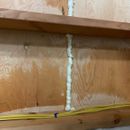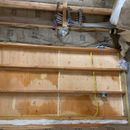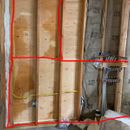Condensation forming inside wall cavity (zone 6)
I’m in the process of building a woodshop and recently noticed some condensation forming on the exterior sheathing behind the insulation in the unfinished utility room (see attached photos). The rest of the walls have taped drywall so I’m not worried about those areas but my original plan was to just put unpainted 1/2″ plywood on the walls in this room so I can easily remove them to access electrical, plumbing, etc.
The exterior side of this north-facing wall is a covered (future screened-in) porch currently just has the 3/4″ sanded plywood and does receive some blown in moisture. The plan next summer was to clad this wall in some shiplapped ash that we milled recently from trees harvested on the property.
I have 2 questions I wanted to solicit some opinions on:
1) Will the paper-faced insulation plus the plywood be a suitable vapor barrier to prevent this from happening over the long run (provided I unfold and staple the craft paper properly)? I can install 6-mil poly over the insulation behind the plywood if absolutely needed but it will prevent me from easily accessing this wall cavity in the future and I sort of expect to need to when I’m working on the porch side of this wall as my wife we will probably want to install some additional lighting, outlets, etc.
1B) If I do install poly over the insulation, do I need to pull out the insulation and dry everything out well first?
2) My original plan was to finish nail + PL the ash directly to the plywood to avoid exposed fasteners which would mean there would be no house wrap on this facade. Again, this is a covered porch that does receive a little blown moisture but less so when the screening goes in. The ash will be varnished for its protection but is it a mistake to not add Tyvek? If this were fully exposed I’m a big fan of installing siding over furring strips over house wrap to provide a drainage/drying plane for water that works its way through the siding but I’d like to avoid it here if possible for ease of cladding installation and the detailing around the door.
Thanks.
Edit: I’m also trying to make sense of why the moisture is forming in certain areas and not others and wanted to solicit some opinions on that as well. I’ve added a third photo that shows where the plywood joints are. I felt behind some additional areas and the moisture isn’t limited to these 3 bays but I didn’t pull everything out to try and map it or anything.
GBA Detail Library
A collection of one thousand construction details organized by climate and house part












Replies
Brandon, that is typical in a cold climate without interior air or vapor control. The insulation keeps the sheathing cold but allows relatively warm, moist air to reach the sheathing, where it condenses. Do you have vinyl siding or rain screen siding? If so, painted drywall is all the IRC model code requires on the interior. (Edit: for up to climate zone 5.) If you have cladding with no rain screen, you need a class 1 or 2 vapor retarder at the interior--variable permeance membranes such as Siga Majrex or Pro Clima Intello are good options for that.
In your Z6 with plywood ext sheathing and vented cladding, a Class III vapor retarder (like typical painted drywall) doesn't meet code. Kraft-faced insulation does, but only works properly when combined with a reasonable interior side air barrier (eg, taped membrane, taped drywall, taped or gasketed plywood).
Thanks guys. The exterior of this wall is a covered screened porch and will be non-vented wood siding. I was planning on using untaped plywood on the interior in this utility room so it sounds like I should go with a Class 1 or 2 film barrier beneath the plywood.
EDIT: The chart I'm looking up says craft-faced insulation has a 1.0 Perm and 1/4" plywood has a 0.7 perm. Seems like 1/2" plywood plus the craft-faced insulation should qualify has a Class 2 barrier no?
I looked up both of those recommended products (Siga Majrex or Pro Clima Intello) and they appear to be European and not easily sourced via the big box stores. Would Certain Teed MemBrain work?
Yes, no need for any kind of membrane if you tape or gasket interior side plywood.
Thanks Jon. I anticipate needing future access to this wall cavity so I'd like to avoid taping the plywood joints if possible. Is there a way to gasket horizontal plywood joints that don't fall on a stud? What is typically used for gasketing material?
http://www.conservationtechnology.com/building_gaskets.html
Thank you.